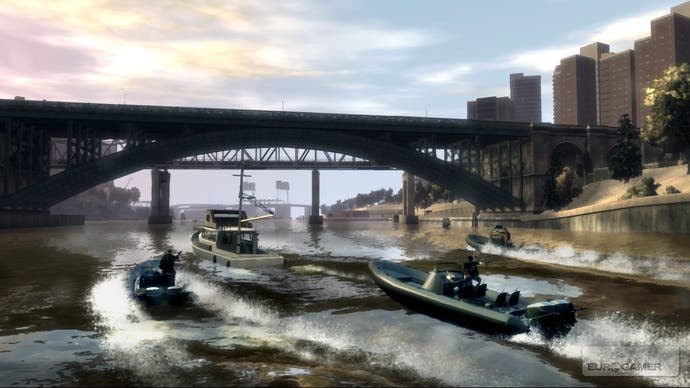Grand Theft Auto IV's Aaron Garbut: Part 1
Rockstar's art director on how GTA is made.
Grand Theft Auto IV is finished. It's on the way to the shops right now, in a herd of lorries guarded by helicopter gunships and men who wear sunglasses indoors and keep touching their radio earpieces ostentatiously. The information they're being fed is that you can't have it. Not yet. Not for another week.
What you can do, though, is read over our interview with the Grand Theft Auto series' art director Aaron Garbut, who spoke to us last week about GTA IV's development - from the initial brainstorming and first programming and planning steps, including the all-important location research, to script refinement and how missions are integrated.
That's all in part one today. And if you check back tomorrow, you can find out how Rockstar approaches game development, what cats and diarrhoea have got to do with the game's enormous number of fake brands, and what GTA IV has in common with the game that propelled the series to superstardom in the first place, GTA III. All of it spoiler-free. Enjoy.
Firstly we just start collecting ideas. Locations, technology, gameplay, missions, basically everything and anything we want to include or do. We think about what we are trying to achieve in basic terms, we spend a bit of time sorting and discarding some of the initial ideas. Then we just start...
In terms of the art department, the character artists will start playing about with concepts, trying various main characters in the game, playing about with pushing the style a little, basically experimenting. The vehicle department will begin a first pass of every vehicle, the environment artists will lay out a road network and once we've all driven around on it for a bit will block in each city block roughly so we can start to see the skyline. The intention is that as soon as possible we have a very, very rough version of the game and then we begin to refine it. Like every other aspect of the game the artistic direction grows organically, we try stuff and things that work pull us in their direction and things that don't are changed.

Right at the start the ambient characters are blocked in, there is a first pass that gives us an initial version of them and as the style tightens and the artists become more confident with the tools we go over them again and again and tighten them up, add varieties and consistency. The main characters all wait for the script. We work from some initial biographies while the script is still in its early stages and then again push these further when the script evolves.
Not really. We always aim to get as much reference as possible regardless of the platform. It's always going to be reusable in some way and building up a library of this stuff is really useful. The first reference trip happens fairly early in the project, not long after we have the initial block in. At this stage in the project we were still fairly unsure of what the power of each system was. When we did the second reference trip though it was much more focused. We had a fairly evolved game by this point and were able to get exactly what we needed to help us in areas we were struggling with.

I think the key difference in approach this time was that we just didn't take the easy way out, not that it was ever easy before. We just shot the action we wanted and then dealt with it when it arrived. Having any sort of interaction like this always adds to your problems, and now that you can see those problems in HD we couldn't really hide anything. On this project though, there was a decision to make as few compromises in all aspects as possible. Just to try stuff we might have shied away from in the past and see if we could manage.
I think the level of detail the cut-scene guys have achieved is intense. They have the characters interacting with the world, which is hard enough, but they also have added a lot of feedback onto the world. Some of it is so subtle you sometimes don't even notice (though you would if they hadn't done it). Things like pillows and mattresses bending or bouncing a little under the weight of characters sitting on it, phone cords dangling and following the phones movements, liquid moving around in glasses. It's pretty amazing.
There's so much of this stuff, all the characters just feel part of the world, they lean on or against things, interact with each other, push things about, knock things over. I think we have more of this stuff in one scene than we had in the entirety of previous GTAs.
To get to your question though, I think it was more of a mindshift than anything else; we just decided to go for it.
There were a few other versions of Niko that went down slightly different routes, but he evolved into more or less his final look pretty early in the day. I'm sure he would have worked in a number of ways, but when we got to what was essentially the version you've seen, he just seemed right. He had a good feel about him, he looked like he had a history, and he looked different.

